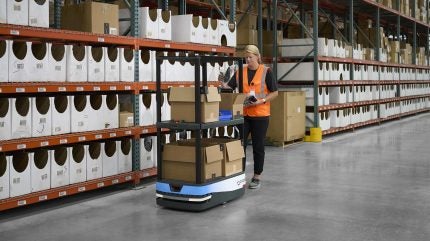
Healthcare manufacturers and distributors are under unprecedented pressure to operate warehouses efficiently. At the same time demand for rehabilitation and mobility aids is rising as the global population ages.
This creates a double bind: more orders to fulfil and not enough workers available. In non-automated warehouses, operatives face repetitive, physically demanding tasks such as picking, packing, and loading. Routes that aren’t optimised means workers will end up wasting time on unnecessary long walks down aisles. These factors increase fatigue and raise the risk of injury.
The more humans involved in these tasks, the more potential for human error, which makes SLA breaches more likely.
To address this, many warehouse operations managers are turning to automation, including robotics, to reduce the strain on labour and improve efficiency and productivity. The global robotics market was already worth $76.1billion in 2023 and is projected to grow to $217.6 billion by 2030 [1].
Digital transformation of warehouses is expected to drive a significant portion of that growth.
Performance Health is one business that truly appreciates the power of an automated warehouse facility, using collaborative robots – or cobots – to support the picking process.
After deploying 35 autonomous mobile robots (AMRs) supplied by Ocado Intelligent Automation (OIA) in its Indianapolis facility, the largest supplier of rehabilitation products in North America says the productivity savings were achieved within just three weeks.
Impressive metrics
Ryan Hetzler is director of distribution at Performance Health. He says: “We saw about a 10% lift in our already elevated units or lines per hour. So, it made a huge difference in eliminating the walking. It was within a three-week period. You could see it right away.”
He highlights other impressive metrics.
The number of units processed per hour in the facility doubled, increasing by more than 100% from 121 to 247. The walking time between picks reduced from 46.5 seconds to 23.7 seconds – a 49% decline. Time spent at the pick face fell from 44 seconds to 26.57 seconds, a 39.6% decrease.
Significantly, the amount of time spent walking between the aisles plummeted by 69%, from 25 seconds per line to just 7.7 seconds. Furthermore, the fleet of AMRs – nicknamed Chucks – worked seamlessly with Packsize, a recently introduced packing technology that produces custom-sized boxes on demand.
Before the introduction of the Ocado Mobile Robot System (OMRS) and fulfilment execution software, the company’s warehouse operations were facing challenges on multiple fronts.
Its distribution facility is 460,000ft2 and runs on the Manhattan warehouse management system (WMS). Approximately 140 staff work at the centre over two shifts, processing between 11,000 and 15,000 lines daily. This is equivalent to 5,000 to 7,000 orders, or 44,000 to 60,000 units per day.
Workers were spending an excessive amount of time picking and walking to and from stock keeping units (SKUs). Out-of-aisle walks were taking 25 seconds per line with 44-second average pick times.
The impact of Ocado’s cobots – the Chucks – was transformative.
The orchestration software dynamically groups the orders to create optimised cart runs that prioritise time-sensitive orders. The Ocado AMRs are programmed to be spatially aware and so avoid colliding with other robots in close quarters. In addition, Ocado’s software plans their paths around the facility to avoid creating bottlenecks and congestion.
The data generated and collected is tracked for further analysis and refinement.
The Chucks are designed to be collaborative and work alongside warehouse operatives, making their jobs easier rather than replacing them. The planned routes reduce the number of steps their human coworkers need to take. Each cobot has a digital interface, allowing the staff to clearly identify the unit to be picked. This reduces the error rate and mitigates mental and physical fatigue in human workers.
As a result, the workforce quickly saw the benefits enabled by the introduction of the AMRs.
Automation as a strategic advantage
The OMRS not only speeds up tasks, it also reimagines workflows by processing real-time data in the cloud-based platform to be as efficient as possible. The system learns patterns to optimise movement and minimise congestion. Manual cart pushing and route planning are eliminated, and orders that are critical for SLA compliance are prioritised.
Best known for its innovation in grocery ecommerce logistics, Ocado expanded its technology into new markets with the acquisition of the company behind OMRS, 6 River Systems in 2022 and began working with Performance Health the same year. The platform integrates AMRs with existing warehouse management systems to streamline fulfilment and improve warehouse productivity – essential in healthcare, where time sensitivity and compliance are critical.
Digital technologies, especially intelligent automation, are increasingly key to the optimisation of warehouse operations. Robotics-as-a-Service (RaaS) is an area where Ocado is a leader. There is growing demand for RaaS as it enables the integration of automation into operations without large upfront investment or in-house expertise. It is predicted that RaaS models are set to experience the biggest growth in warehouse and logistics operations [2], evidenced by the successful rollout of cobots by Performance Health.
“Fulfilment in healthcare needs to be reimagined for companies to ramp up productivity without adding headcount cost, while also using their workforce in the most effective way,” says Jeff Larson, VP of solutions architecture at OIA “Building on the decades of expertise we have in grocery fulfilment; we have developed warehouse technology that works for other complex sectors. Our Chuck AMR hardware is part of that solution. Intelligent software that facilitates the dance of orders, workers and these robots is the other critical part of the equation.”
Download Ocado’s whitepaper to read more about how automation and mobile robots are transforming pharma warehouse management and fulfilment operations.
[1] GlobalData, Thematic Intelligence: Robotics, 2024
[2] GlobalData, Thematic Intelligence: Robotics, 2024




